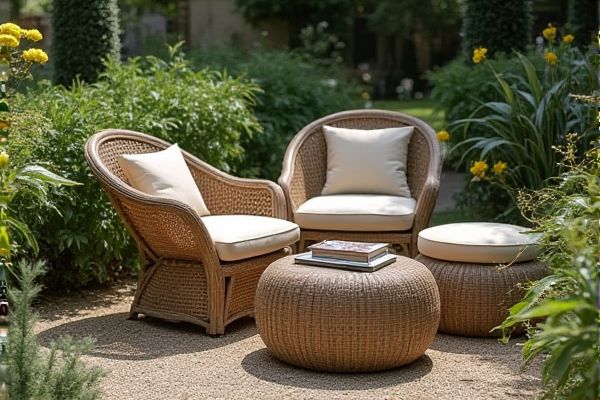
A garden stool offers durable outdoor seating with weather-resistant materials and often doubles as a decorative accent or side table, while an ottoman primarily serves as indoor furniture for footrest or extra seating with plush upholstery. Explore the rest of the article to discover which option best suits Your space and lifestyle needs.
Table of Comparison
| Feature | Garden Stool | Ottoman |
|---|---|---|
| Primary Use | Outdoor seating and decorative accent | Indoor footrest and additional seating |
| Material | Ceramic, metal, stone, or weather-resistant materials | Upholstered fabric, leather, wood, or synthetic materials |
| Durability | High resistance to weather and moisture | Mostly indoor use; less water-resistant |
| Portability | Generally lightweight and easy to move outdoors | Often bulkier and heavier |
| Storage | Usually solid or hollow with limited storage options | Often includes internal storage compartments |
| Design Style | Traditional, artistic, often ornate | Modern, plush, versatile designs |
| Functionality | Seating, side table, decor element | Footrest, seating, storage |
| Common Locations | Gardens, patios, outdoor living spaces | Living rooms, bedrooms, lounges |
Garden Stool vs Ottoman: Key Differences
Garden stools are typically made of durable materials like ceramic or metal, designed for outdoor use and resistant to weather conditions. Ottomans offer soft, cushioned seating or footrest options, often upholstered and intended for indoor comfort and style. Your choice depends on whether you prioritize outdoor durability with a garden stool or indoor comfort and versatility with an ottoman.
Materials and Durability Comparison
Garden stools are typically crafted from ceramic, metal, or resin, offering robust resistance to outdoor elements such as rain, UV rays, and temperature fluctuations, ensuring long-lasting durability. Ottomans, often made with fabric upholstery and cushioned interiors atop wooden or metal frames, prioritize indoor comfort but may require weather-resistant treatments for outdoor use. The choice between the two depends on material resilience and intended environment, with garden stools excelling in outdoor durability and ottomans providing softer, versatile seating options indoors.
Design and Style Options
Garden stools offer a versatile range of design and style options, featuring materials like ceramic, metal, and wood that enhance outdoor aesthetics with intricate patterns and vibrant colors. Ottomans provide plush, upholstered surfaces in various fabrics and patterns, tailored to indoor comfort and decor themes. Both pieces serve functional roles, but garden stools emphasize durability and artistic appeal, while ottomans prioritize softness and indoor style versatility.
Functionality and Versatility
Garden stools offer multifunctional use as both seating and decorative plant stands, making them ideal for outdoor spaces. Ottomans primarily provide comfortable footrests or extra seating indoors, often featuring storage compartments for added practicality. Choosing between a garden stool and ottoman depends on your need for durability and adaptability in outdoor versus indoor environments.
Indoor vs Outdoor Suitability
Garden stools are designed primarily for outdoor use, featuring weather-resistant materials like ceramic, metal, or resin that withstand moisture and sun exposure. Ottomans are generally intended for indoor settings, crafted with fabrics or upholstery that may not endure outdoor conditions without damage. Choosing the right piece depends on your intended use, as your garden stool offers durability for patios while ottomans provide comfort and style for indoor living spaces.
Comfort and Ergonomics
Garden stools typically offer firm seating with minimal cushioning, making them less comfortable for extended use compared to ottomans designed with plush padding and ergonomic contours that support leg elevation and posture. Ottomans often feature soft upholstery, enhancing comfort by allowing better pressure distribution and reducing fatigue during prolonged sitting. For outdoor settings, garden stools provide durability and weather resistance but sacrifice ergonomic support, whereas ottomans prioritize user comfort and body alignment, especially in indoor environments.
Storage Features and Practicality
Garden stools often provide built-in storage compartments, making them practical for stashing gardening tools or outdoor accessories. Ottomans typically feature hollow interiors or removable tops, offering versatile storage for blankets, pillows, or magazines. Both furniture types enhance space efficiency, but garden stools are more suited for outdoor use, while ottomans integrate seamlessly into indoor living areas.
Maintenance and Cleaning Tips
Garden stools require minimal maintenance, often made from weather-resistant materials like ceramic or metal that can be cleaned with a damp cloth to prevent dirt buildup. Ottomans with fabric upholstery need regular vacuuming and occasional spot cleaning to avoid stains, while removable covers can be machine washed for deeper cleaning. You can prolong the life of both furniture pieces by storing them indoors or using protective covers during harsh weather.
Price Range and Value
Garden stools typically range from $50 to $200, offering durable, weather-resistant materials ideal for outdoor use, which enhances their long-term value. Ottomans vary more widely in price, from $100 to over $500, depending on design complexity and upholstery, providing versatile indoor comfort and style. For your budget, a garden stool offers cost-effective outdoor functionality, while an ottoman delivers greater aesthetic and comfort value indoors.
Choosing the Best Option for Your Space
Garden stools offer a versatile blend of outdoor durability and elegant design, making them ideal for patios or garden settings where weather resistance is crucial. Ottomans provide plush comfort and can double as footrests or extra seating, best suited for indoor spaces or covered areas where softness and coziness enhance relaxation. Your choice depends on whether you prioritize weatherproof functionality or cushioned comfort to complement your space.
 homyna.com
homyna.com